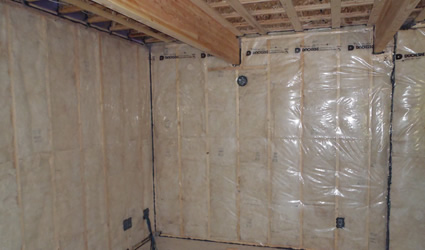By definition straight from Wikipedia “R-value is a measure of thermal resistance used in the building and construction industry. Under uniform conditions it is the ratio of the temperature difference across an insulator.”
Read the definition carefully because there are problems associated with it. Note it says “under uniform conditions.” Uniform conditions exist in a lab where there is no wind, no extreme differences in temperature and the insulation is installed in absolute perfect condition with no wires, boxes or abnormal shapes to deteriorate its effectiveness. Does this sound like your new home or building? I didn’t think so.
R-value is very important however it is not the be all and end all in determining the effectiveness of an insulation material. The content below is from a book entitled “Urethane Foam” by David B. South. I know it is long, but it is very much worth reading.
“The R-value is a modern fairy tale. It’s a fairy tale that has been so touted to the consumer that it now has a chiseled in-stone status. But the saddest part of this fairy tale is that the R-value by itself is almost a worthless number.
It is impossible to define an insulation with a single number. To do so, we must know more. So why do we allow the R-value fairy tale to perpetuate? I don’t know. I don’t know if anybody knows. What we do know is that the R-value fairy tale obviously favors fiber insulation.
Consider the R-value of an insulation after it has been submersed in water or as a 20 mile-per-hour wind blows through it. In either of these scenarios, the R-value of fiber insulations goes to zero. But those same conditions barely affect solid insulations. That’s why I believe that R-value numbers are misleading, meaningless numbers unless we know other characteristics.
In all probability, no one would ever buy a piece of property knowing only one of its dimensions. Suppose someone offered a property for $10,000 and told you it was a seven. You would instantly wonder what that number referred to: Seven acres? Seven square feet? Seven miles square? What? You would also want to know the property’s location: In a swamp? On a mountain? In other words, one number cannot accurately describe anything, and that includes the value of an insulation.
Nevertheless we have Code bodies mandating R-values of 20s or 30s or 40s. But a fiber insulation with an R-value of 25 placed in an improperly sealed house will allow wind to blow through it as if there were no insulation. Maybe the R-value is accurate when the material is lab tested. But a lab environment may not even remotely duplicate conditions in the real world.
Consequently, we must start asking for some additional dimensions to our insulation. We need to know its resistance to air penetration, to free water, and to vapor drive. We must begin demanding the R-value of an insulating material after it is subjected to real world conditions.
R-value testing does not account for air movement (wind) or any amount of moisture (water vapor). In other words, the test used to create the R-value is a test in non-real-world conditions. For instance, fiberglass is generally assigned an R-value of approximately 3.5. It will only achieve that R-value if tested in an absolute zero wind and zero moisture environments. Zero wind and zero moisture are not real-world. Our houses leak air, all our buildings leak air, and they often leak water. Water vapor from the atmosphere, showers, cooking, breathing, etc. constantly moves back and forth through walls and ceilings. If an attic is not properly ventilated, water vapor from inside a house will very quickly semi-saturate the insulation above the ceilings. Even small amounts of moisture will cause a R-value to drop 50% or more in fibre based insulations.”

